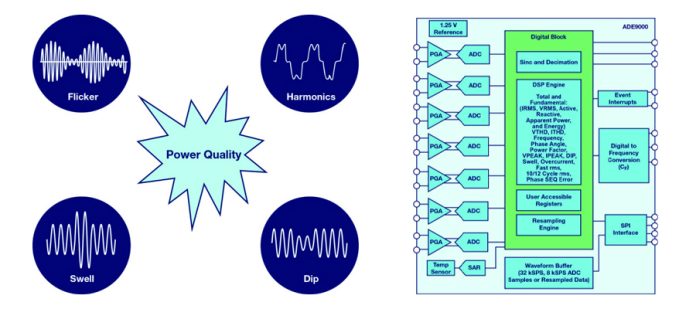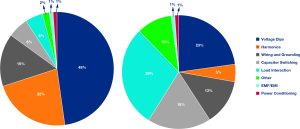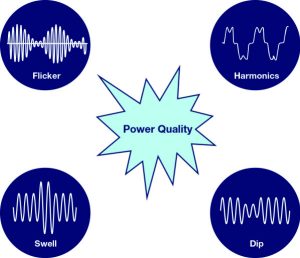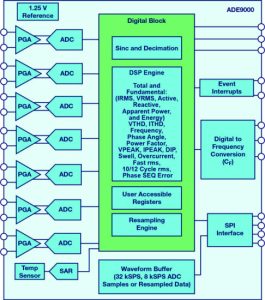Swarnab Banerjee, System Engineering Manager, ADI & Niranjan Chandrappa, Product Applications Engineer, ADI
According to a recent study published by the Electric Power Research Institute (EPRI), large industrial facilities in the U.S. lose over $100 billion every year due to power problems, including power supply variations and voltage disturbances. When the lights flicker at home, it’s an annoyance. But when power is disturbed at a factory, it can cause the malfunction and early breakdown of expensive equipment. Subtle power quality events often pass through traditional protection networks undetected and contribute to equipment degradation over time. Furthermore, the source of many power quality disturbances are the loads connected to the same network, causing disturbances to propagate through adjacent facilities and buildings. In order to overcome power quality challenges, it is necessary to monitor inputs and disturbances generated by the load. Power quality monitoring can provide appropriate protection to equipment and can help identify suitable mitigation techniques that improve power quality.
If stakeholders take full advantage of the technology, their expensive infrastructure will benefit from clean power and an extended life.
Power quality refers to a wide variety of variations in the electric power supplied to utility customers. It can cover wiring problems, grounding issues, switching transients, load variations, and harmonic generations. In some cases, poor power quality can go undetected, yet damage expensive equipment. In Europe, the quality of electricity that is provided by a grid operator is defined by the reference parameters set in the national grid codes and the European standards (EN 50160). When the supply voltage is distorted, a device draws nonsinusoidal currents and can cause many technical problems such as overheating, malfunction, and premature aging. The nonsinusoidal current also causes thermal and insulation stress on network devices, such as transformers and feeder cables. Poor power quality ultimately results in financial losses caused by equipment downtime, increased maintenance activities, and shorter life times. In this article the impacts of poor power quality will be analyzed from the perspective of industrial equipment and how to maximize machine health.
Figure 1. Different sources of power quality problems in a) United States b) Europe.
Where Do Power Quality Disturbances Originate?
Figure 1a summarizes a study that the Electric Power Research Institute conducted for distribution power quality among 24 utilities throughout the U.S. The majority (85%) of power quality incidents originate from voltage dips or swells, harmonics and wiring, and grounding problems. Figure 1b shows the results of a different European Power Quality survey, which estimated that power quality problems in EU-25 countries create financial loss of more than $156 billion per year (€150 billion). In industrial settings, starting and stopping of heavy loads can result in voltage sags and swells that move the network voltages outside the standard operating condition. As most equipment is designed to operate within a certain operating condition, prolonged voltage dips and swells result in shutdowns and process outages. In today’s business climate, many companies are considering or already installing locally generated renewable energy sources, such as solar and wind. In many cases, distributed generation sources introduce a need for switch mode power supplies in electrical installations. With the increased adoption of power electronics and switching power supplies, harmonics will become a more common source of power quality problems in industrial equipment. These types of power supplies can inject harmonics on electrical lines and degrade power quality so that everything tied to the supply network is impacted, including transformers and cables. Facility managers can often observe impacts of large harmonic currents as the network components get overloaded. In some cases, increases in total losses of 0.1% to 0.5% on network components can cause tripping of protection devices. Some other occurrences that can contribute to poor power quality include differential loading of phases, incorrect wiring and grounding schemes, load interactions, EMI/EMC, and switching of large reactive networks.
Figure 2. Visualization of network voltages and currents under different distortion effects.
Power Quality Standards
In order to cope with and manage power quality, one must find a reliable monitoring and reporting method. Some of the key standards created by industry are IEC 61000-4-30 Class A and Class S, IEC61000-4-7 harmonic measurements, and IEC61000-4-15 for flicker. Most utilities have adopted these power quality standards to develop and enforce regulations. In certain cases, utilities may penalize a customer if power quality standards do not meet regulations. Industry standards not only establish a common understanding of power quality in real-world applications, but also give users confidence they will have accurate data to solve problems and issues related to events. In electrical networks, voltage sags, swells, flickers, variation in nominal ratings, and distortion due to harmonics—all contain the key information regarding the electrical health of the network. Measurement accuracy is the key to providing reliable and repeatable results.
Applying Power Quality Monitoring to Improve Grid and Machine Health
Modern day power quality devices provide information that will benchmark the overall system performance, assist in preventive maintenance, monitor trends and conditions, assess network performance and sensitivity to process equipment, and improve energy rates. A network of power quality monitors can be installed on supply systems, and their raw measurement data can be aggregated to correlate and help identify sources of disturbances. Power quality monitors can also be a part of embedded equipment design for tighter integration and control. A unique electrical signature of a machine can be captured to understand overall health. Conclusions from data analysis and diagnostics can provide reliable input to design next-generation protection algorithms and products to improve power quality.
If equipment has already been deployed in a factory environment, the power quality profile can be used to determine the best mitigation techniques. For instance, power quality profiling of an industrial facility in India revealed significant distortions of voltage and current waveforms. After extensive analysis, a hybrid power factor correction system was installed in the factory. With the new correction system, the power factor changed from –0.5 to +0.9 and THD improved by 50%.
A Modern Power Quality Analyzer
In the past, designing a high accuracy, power quality analyzer required significant technical skill and often involved using discrete components and developing custom power quality measurement algorithms. A new class of power quality analog front ends (AFEs) integrates high performance ADCs with low drift overall gain and a DSP core. This integrated AFE reduces the complexity and cost associated with the discrete design approach and writing custom algorithms.
The integrated AFE calculates and provides power quality parameters such as sag, swell, rms, phase sequence error, and power factor values. It also obtains line frequency harmonic content from the input signal. Analog Devices has mastered a world class, power quality monitor front end called the ADE9000. It absorbs most complexity in calculations and simplifies the time and effort to implement a power quality monitoring system.
Figure 3. Information and reporting from power quality monitors.
Figure 4. Functional block diagram of ADE9000. Highly integrated, multiphase energy, and power quality monitoring IC.
Figure 5. Typical power quality monitoring system signal chain.
Opportunities for Big Data Analytics That Drive Better Energy Intelligence
As individual devices in industrial settings become more connected and IoT deployments accelerate, power quality information from distributed equipment will be collected and leveraged in new ways. For example, stakeholders can analyze historic trends and enable early detection of an emerging problem. Within a network, real-time data from multiple nodes can be used to identify and isolate a disturbance. Data analytics for machine diagnostics, preventive maintenance, and isolation of problem loads are new ways to reduce process interruptions, increase equipment lifetime, and improve uptime.














